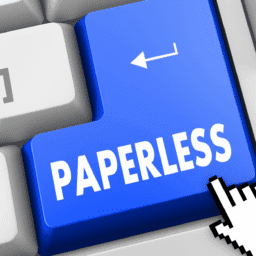Companies’ methods to onboard new employees can significantly impact their operational efficiency and overall success. Two primary approaches dominate this space: traditional manual onboarding and the increasingly popular paperless onboarding. This article provides a side-by-side comparison of these two methods, highlighting their differences, advantages, and disadvantages.
 Definition and Process
Definition and Process
Manual Onboarding: This traditional approach involves a significant amount of paperwork. New hires fill out forms by hand, which are then processed manually by HR. This method often requires physical storage of documents and face-to-face interactions for completion.
Paperless Onboarding: Leveraging digital tools and software, paperless onboarding automates and manages the entire process electronically. New employees complete forms online, and data is stored in cloud-based systems, significantly reducing the need for physical paperwork.
Efficiency and Time Consumption
Manual Onboarding: Typically time-consuming due to the need for physical handling, manual data entry, and slower processing of paper documents. The pace of onboarding is often dependent on the speed at which paperwork is completed and processed.
Paperless Onboarding: Streamlines the onboarding process, significantly reducing the time taken from the initial job offer to the employee’s first day. Automated workflows and digital document management accelerate every stage of onboarding.
Accuracy and Compliance
Manual Onboarding: Prone to human error during data entry and document management. Ensuring compliance with employment laws can be challenging and requires constant vigilance and updates to physical documents.
Paperless Onboarding: Offers greater accuracy due to reduced manual input. Compliance is easier to maintain as digital systems can be updated quickly to reflect current laws and regulations.
Cost Implications
Manual Onboarding: Incurs costs for printing, paper, storage, and additional personnel for data entry and document management. These costs can accumulate significantly over time.
Paperless Onboarding: Although there may be initial costs for software implementation, in the long run, it reduces expenses related to printing, storage, and personnel. The efficiency gains also contribute to indirect cost savings.
Employee Experience
Manual Onboarding: Can be overwhelming for new hires due to the volume of paperwork. The process can seem outdated, especially to tech-savvy new generations entering the workforce.
Paperless Onboarding: Generally provides a more streamlined and user-friendly experience. Digital onboarding platforms can offer interactive and engaging content, enhancing the new hire’s first impression of the company.
Environmental Impact
Manual Onboarding: Has a larger environmental footprint due to reliance on paper, which contributes to deforestation and waste.
Paperless Onboarding: More environmentally sustainable as it significantly reduces paper use, aligning with green business practices and eco-conscious corporate values.
Data Security and Accessibility
Manual Onboarding: Storing physical documents can pose security risks and challenges in data protection. Accessibility is limited to physical location and office hours.
Paperless Onboarding: Offers enhanced data security with encrypted digital storage. Cloud-based systems provide accessibility anytime, anywhere, which is particularly beneficial for remote or global teams.
Scalability
Manual Onboarding: Scaling up manual onboarding processes can be cumbersome and resource-intensive, especially for rapidly growing companies.
Paperless Onboarding: Easily scalable to accommodate business growth. Digital systems can handle an increased volume of onboarding without a proportional increase in resource allocation.
Conclusion
The comparison between paperless and manual onboarding paints a clear picture: the digital approach offers numerous advantages in terms of efficiency, cost-effectiveness, compliance, employee experience, and environmental impact. While the transition to paperless onboarding requires an initial investment in technology and training, the long-term benefits it provides make it an increasingly essential tool for modern businesses. As companies continue to seek ways to streamline their operations and adapt to a digital future, paperless onboarding stands out as a key strategy in achieving these goals.




